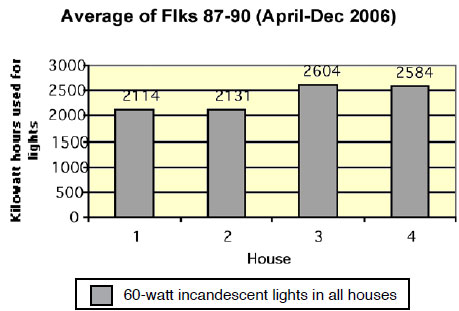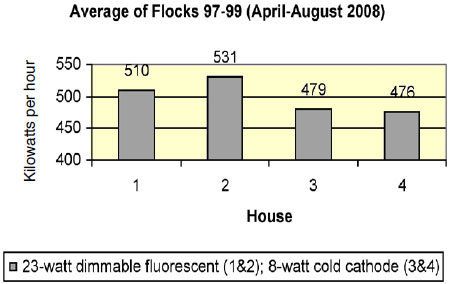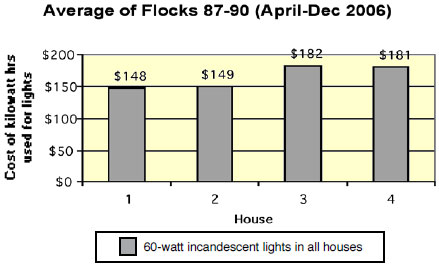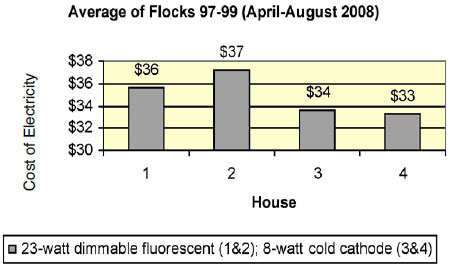



Energy Efficiency Associated with Poultry House Lighting
Research at the University of Arkansas shows that significant energy and cost savings can be made by changing the lighting system in solid-walled poultry houses. G.T. Tabler, S.E. Watkins and P.A. Watkins from the University of Arkansas Division of Agriculture and AEP Southwestern Electric Power Company outline the details in the latest issue of Avian Advice.Introduction
Solid sidewall poultry housing has created a situation where lighting is now a major cost center. Loss of natural daylight means any light birds receive is now provided artificially with bulbs, which have an energy cost associated with them.

Currently, incandescent, fluorescent, high pressure sodium, cold cathode and others lighting options are available to poultry producers but choosing the correct one can be difficult. Since April 2006, the Applied Broiler Research Farm (ABRF) has evaluated the energy usage associated with different light sources.
Energy Use and Cost for Lighting
The ABRF sub-meters electricity used for lighting through a separate electric meter that allows accurate measurement of lighting kilowatt hour electricity usage.
After farm renovations were completed in April 2006, all 4 houses had 2 rows of 60-watt incandescent lights above the feed lines and a center row of brood lights that was 75-watt incandescent. Houses 1 and 2 have a total of 75 bulbs (42 dimmable lights plus 33 brood lights) while houses 3 and 4 have a total of 90 bulbs (50 dimmable lights plus 40 brood lights). Prior to the start of the December 2006 flock, the 60-watt incandescent dimmable lights in house 3 were replaced with 8-watt dimmable cold cathode bulbs with a 2700 Kelvin rating. Incandescent brood lights were not changed.
A second flock was placed and bird weights (as measured by in-house bird scales) in the 2700 Kelvin light house began to decline once the brood lights were turned off. The brood lights were turned back on until birds were 5 weeks old to help stimulate growth and this resulted in less electricity savings difference.
It was found that the current strain of birds are more sensitive to light intensity and the 2700 Kelvin cold cathode only provided 0.35 to 0.50 foot-candles at the feed line compared to 0.5 foot-candles in the incandescent houses. In addition, the 2700 Kelvin cold cathode bulb gave off an orange tint similar to a 60- or 75-watt incandescent bulb.
To help address these concerns, we began working with an Arkansas lighting vendor (Precision Lighting Systems Inc., Hot Springs, Arkansas).
Prior to the May 2007 flock, the incandescent dimmable lights in house 4 were replaced with 8-watt cold cathode bulbs with a 4000 Kelvin rating. These bulbs have a slight bluish tint compared to the orange tint of the 2700 Kelvin bulb; and, are able to deliver 0.50 foot-candles of light at the feed line. Therefore, the May 2007 flock consisted of all incandescent bulbs in houses 1 and 2, incandescent brood lights and 2700 Kelvin 8-watt cold cathode dimmable lights in house 3, and incandescent brood lights and 4000 Kelvin 8-watt cold cathode dimmable lights in house 4.
The kilowatt hour usage for lights during the flock was 2,527, 2,521, 1,852 and 1,154 for houses 1, 2, 3 and 4, respectively. Cost associated with this usage was $152, $151, $111 and $69 for houses 1 through 4, respectively.
For the February and May 2007 flocks, it was necessary to leave the incandescent brood lights on in house 3 until 5 weeks of age in an attempt to stimulate the birds to eat more feed with an increased light intensity. However, house 4 with the 4000 Kelvin cold cathode and a 0.5 foot-candle light intensity at the feed line did not have problems with decreased weight gains. The conclusion from this evaluation was that the 4000 Kelvin cold cathode would provide adequate light intensity for proper bird growth and feed consumption while providing producers with an energy-efficient lighting source.
Lighting sources for the July 2007 flock was as follows:
- House 3 – 2700 Kelvin cold cathode lights were changed to 4000 Kelvin cold cathodes
- Houses 3 and 4 – all incandescent brood lights were replaced with 15-watt fluorescent above the feed lines and 30-watt fluorescent down the center row.
Prior to the October 2007 flock, all incandescent lights in house 2 were replaced with 23-watt dimmable fluorescent bulbs. Kilowatt hour usage for lighting was 1,722, 478, 502 and 535 for houses 1 through 4, respectively. Energy cost was $122, $33, $35 and $37 for houses 1 through 4, respectively.
Prior to the February 2008 flock, all incandescent lights in house 1 were replaced with 23-watt dimmable fluorescent bulbs. Kilowatt hour usage for lighting on this flock was 561, 590, 474 and 453 hrs for houses 1 through 4, respectively. Energy cost for lighting was $39, $41, $33 and $32 for houses 1 through 4, respectively.
Switching to energy-efficient bulbs has dramatically cut energy usage and costs associated with lighting at the ABRF. Immediately after farm renovation (April through November 2006) when all 4 houses were using 60- and 75-watt incandescent bulbs, kilowatt hour usage for lights on the farm averaged 9,432 hrs at a cost of $660 per flock over a 4-flock period.
From February through August 2008, with houses 1 and 2 using 23-watt dimmable fluorescent bulbs and houses 3 and 4 using a combination of 15- and 30-watt fluorescent brood lights and 8-watt cold cathode grow lights, kilowatt hour usage on the farm for lights averaged 1,996 hours at a cost of $140 for a 3-flock period. Thus, savings after switching to energy-efficient lighting have averaged 7,436 kilowatt hours and $520 per flock at the ABRF.
Bulb failures have been somewhat less on the cold cathode versus the 23-watt dimmable fluorescent; averaging approximately 1 to 2 bulbs every other flock for the cold cathode and 2 to 3 per flock on the dimmable fluorescent.
Kilowatt-hour usage of each individual house for incandescent and energy-efficient lighting is presented in figures 1 and 2, respectively. Cost of incandescent and energy efficient lighting for each house is presented in figures 3 and 4, respectively.
* "Savings after switching to energy-efficient lighting have averaged 7,436 kilowatt hours and $520 per flock." |
There are a number of energy efficient alternatives to incandescent lighting now available although all are more expensive initially than incandescent bulbs. The cold cathode bulbs we are currently using sell for about $9 per bulb but cheaper options are available when bulk purchasing the bulbs. The 23-watt dimmable fluorescent bulbs sell for about $7 per bulb.
However, life expectancy of the cold cathodes is approximately 25,000 hours as compared to an incandescent bulb which has an estimated life span of 2,000-5,000 hours, depending on the quality of the bulbs of these bulbs is much greater than that of an incandescent bulb and it is much less expensive to burn an 8- or 23-watt bulb than it is a 60- , 75- or 100-watt bulb. So think long-term savings, not simply initial up-front bulb cost.
Summary
Solid sidewall housing has many advantages for producers. However, one disadvantage is the increased electricity for lighting.
At present, lighting is an area offering producers much potential in terms of energy conservation. However, it is critical to provide birds with the correct light intensity if expected performance levels are to be met. This can now be done with a variety of different lighting methods (incandescent, fluorescent, cold cathode, sodium vapour etc.). Producers should give serious consideration to lighting alternatives that conserve energy and offer long-term savings.




November 2008









